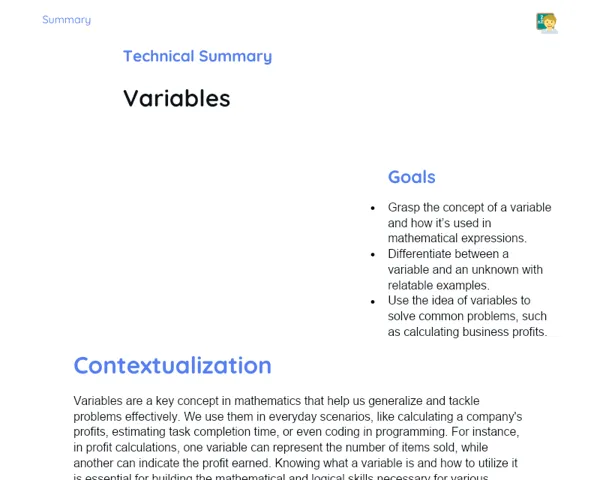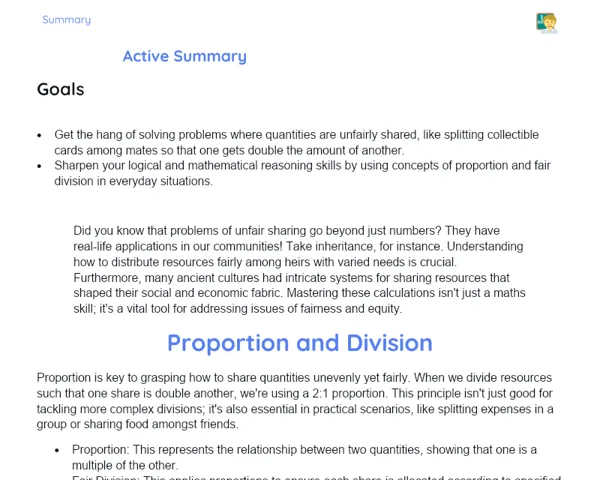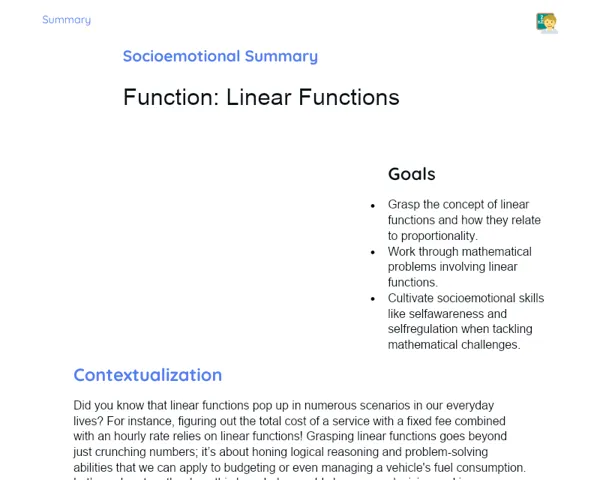Socioemotional Summary Conclusion
Goals
1. Identify measures of central tendency in various chart types 📊
2. Recognize and analyse factors that could lead to reading errors in charts, such as misleading scales, unclear legends, and missing relevant information 🔍
Contextualization
Did you know that charts are like visual superpowers? 💡 They're everywhere: on social media, in news reports, even in games and surveys! But to avoid falling into pitfalls, it’s important to know how to interpret them correctly. Just think about making a vital decision based on a graph with a dodgy scale! 😱 In this lesson, we’ll unlock these mysteries together! 🚀
Exercising Your Knowledge
Key Components of Charts
Charts are graphical representations of data that facilitate quick comprehension of complex information. They consist of various elements that, if not well-constructed and presented, can lead to misunderstandings. Let’s delve into the main components of charts and uncover their unique features.
-
Types of Charts: There are various types of charts such as bar, line, pie, and histogram. Each serves a distinct purpose, and it’s vital to know when to use each type to accurately represent data.
-
Measures of Central Tendency: Mean, median, and mode are crucial to grasping the central tendency of the data presented. In a bar chart, for instance, the mean can be depicted as a horizontal line.
-
Scales and Axes: The scales on the X and Y axes can heavily influence how data is interpreted. It's vital to ensure the scales are appropriate to avoid distorted views.
-
Legends and Titles: Clear legends and well-described titles are foundational for proper chart comprehension. They provide the necessary context for accurately reading the data.
-
Sources and Dates: Citing sources and dates is key for establishing the credibility and contextual understanding of the data. Omitting these elements can lead to misleading information.
Critical Evaluation of Charts
Critically evaluating a chart means looking deeper than just the surface visuals and questioning each detail shown. This allows us to spot potential errors or manipulations that could skew the understanding of the data.
-
Identifying Trends: Observe and determine the central trends in the data, such as the mean, median, or mode.
-
Error Detection: Analyse whether there are misleading or improperly set scales that could distort the data presentation.
-
Legend Verification: Ensure that the legends are clear and appropriately positioned for ease of interpretation.
-
Source Validation: Confirm if the sources and dates of the data are included to establish the chart’s credibility.
-
Awareness of Manipulation: Be mindful that charts can be intentionally altered to guide a specific interpretation. Being critical helps navigate these pitfalls.
Socio-Emotional Reflection
Socio-emotional reflection involves contemplating our emotions and actions during our learning activities. While analysing charts, we might experience a range of emotions, from frustration when spotting mistakes to satisfaction when solving issues. Reflecting on these emotions is crucial to developing skills like self-awareness and self-control.
-
Recognition of Emotions: Acknowledge what emotions were felt when identifying and correcting errors in the charts. This enhances the ability to recognise and articulate emotions.
-
Understanding Emotions: Explore why these emotions surfaced and how they affect our behaviour and decision-making.
-
Expression of Emotions: Reflect on how we express our emotions during these activities and whether we were assertive or reserved.
-
Emotion Regulation: Discuss strategies for handling emotions in the future when working with charts, such as questioning the information and verifying sources.
-
Value of Feedback: Sharing and receiving feedback within groups bolsters social skills and promotes emotional growth.
Key Terms
-
Charts: Visual ways to represent data that assist in understanding and analysing intricate information.
-
Measures of Central Tendency: Encompasses mean, median, and mode, which help identify the central trend of the data.
-
Scales: Divisions along the axes of charts that affect how the data is interpreted.
-
Legends: Explanations that aid in understanding the information present in a chart.
-
Sources and Dates: Information regarding the origin and timing of data collection, essential for confirming credibility.
For Reflection
-
How did you feel when spotting potential errors in charts? What emotions surfaced, and how did you manage them?
-
Why is it important to verify the sources and dates displayed in charts? How does this influence the reliability of the information?
-
How can you apply critical chart interpretation skills in other aspects of your life, like on social media or personal decision-making?
Important Conclusions
-
Charts are powerful tools that assist us in visualising data and making informed choices. 🚀
-
Recognising measures of central tendency, such as mean, median, and mode, in charts is vital for comprehending the data better. 📊
-
Identifying and analysing elements that could cause reading errors, like inaccurate scales and unclear legends, is essential to avoid misunderstandings. 🔍
-
Verifying sources and dates ensures the charts’ credibility and the accuracy of the presented information. 📅
-
Developing socio-emotional skills, such as self-awareness and emotional regulation, equips us to navigate challenges in chart interpretation more effectively. 💡
Impacts on Society
Charts are deeply rooted in our society as they regularly appear across diverse areas such as economics, politics, health, and media. They help simplify complex information and relay data clearly and objectively. Misinterpretation, however, can lead to misguided decisions with serious repercussions. Therefore, cultivated critical and analytical reading of charts is vital.
Moreover, the ability to interpret charts accurately fosters social responsibility. In a world overflowing with information, being able to differentiate between reliable and manipulated data is essential. This not only amplifies our capacity to make informed choices but also enhances our awareness as critical citizens, empowered to question and verify the credibility of the information we encounter daily.
Dealing with Emotions
To aid you in managing your emotions when reading charts, I suggest an exercise based on the RULER method. At home, jot down a situation where you came across a chart that seemed tough to interpret or raised some suspicion. Identify and label the emotions you felt (like frustration, confusion, or curiosity). Then, try to understand what triggered those emotions. Describe how you coped at the time and think about ways to better manage those feelings moving forward, such as verifying sources and discussing uncertainties with peers or teachers.
Study Tips
-
Review the charts you encounter in daily life, like on social media or in the news, and try to spot the measures of central tendency. 📈
-
Engage in critical analysis of charts by examining scales, legends, and sources. This will help cultivate a discerning and analytical mindset. 🧠
-
Partner with a study buddy and discuss the charts you’ve analysed together. Sharing different viewpoints can enrich learning and make studying more engaging and enjoyable. 👥



